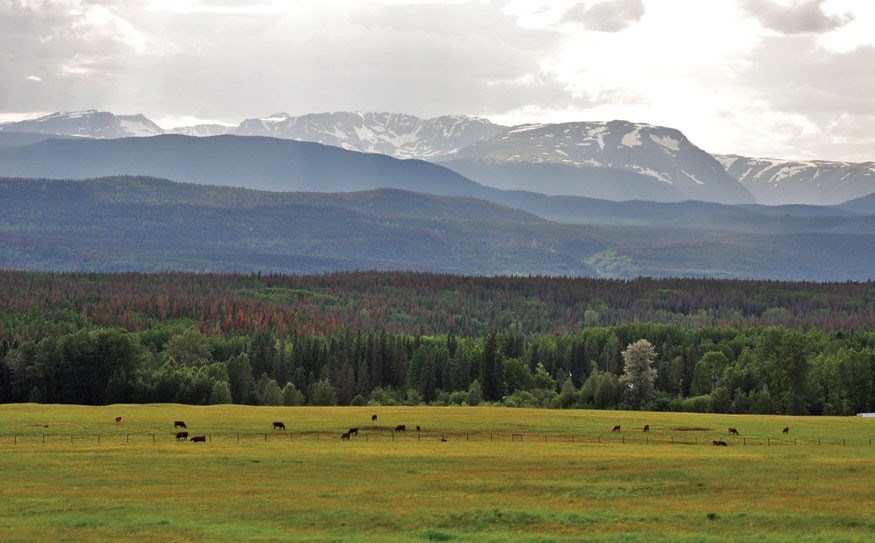If you want to discover the antecedents to modern-day B.C., be prepared to do some travelling on roads that run beside many of the province's major rivers—the Fraser, Thompson, and Columbia—and lakes such as Stuart and Babine. Fur-trading forts established in the early 19th century by the North West Company and the Hudson's Bay Company at places such as Langley, Yale, Kamloops, and Prince George were all linked by an extensive network of watery routes that led east to the Great Lakes and west to the Pacific.
Fort St. James, which lies on the southern shore of vast Stuart Lake, is the oldest continuously inhabited non–First Nations community west of the Rocky Mountains. Simon Fraser established a trading post here in 1806, the first in a network of strongholds that brought goods to Fort Vancouver, at the mouth of the Columbia River. To reach it from present-day Vancouver, travellers must journey to the geographical heart of the province, no small feat given that B.C.'s landmass is larger than Washington state, Oregon, and California rolled into one.
Summer was made for road trips such as this. Not only will your eyes be opened to the vastness of the central Interior, where numerous provincial and private campgrounds offer affordable and scenic spots to rest your head, but places such as Parks Canada's Fort St. James National Historic Site will allow you the chance to magically step back in time. Given that such experiences aren't everyday occurrences, it's difficult to put into words how powerful this can be. Perhaps it's because, living as we do on the West Coast frontier, where post-contact history is measured in puny centuries rather than magnificent millenniums, there are few architectural examples of much significance. To pass through the entrance of Fort St. James is to experience history as it comes alive before your eyes.
Although commercial activity at the fort concluded almost a century ago, an enduring freshness permeates its well-trodden grounds. Atop a grassy plateau overlooking breezy Stuart Lake, boardwalks and pathways connect with wharves and warehouses, living quarters and gardens. Thanks to the sustained efforts of local townsfolk, after the Hudson's Bay Company closed up shop in 1952, the integrity of the fort was maintained until Parks Canada assumed responsibility for the historic site in the 1970s.
When Pique visited last July, locally based staff dressed in late-19th-century attire enthusiastically greeted visitors and deftly fielded their questions. For the past decade, interpretation coordinator Elijah Mattess from the Tl'azt'en First Nation community of Tache, located further north on the eastern shore of Stuart Lake, has overseen the general warehouse and fur store. As crammed to the rafters as the sturdy Red River timber frame structure may appear, Mattess said it contained only a small fraction of the furs stored there at the height of commerce in the 1880s.
"Our collection of soft fox pelts and starched beaver skins has stood up remarkably well since this exhibit first opened 35 years ago," he said. "The sight of so many otter, wolf, wolverine, bear, and even skunk skins may be abhorrent to some people today, but these creatures were plentiful and highly valued a century ago, not just for fashion but also for helping people survive. The winters have warmed up considerably since my childhood, when cold snaps of minus 40 for a week at a time meant no school." Forests infested by the mountain pine beetle in the Cariboo region offer mute testimony to Mattess's observations on climate change.
The smell of freshly baked cookies draws visitors to the Murray House, where Hudson's Bay Company chief factors (high-ranking officials) and their families lived. Lovingly appointed with antique furniture and floor coverings, true to form the home also features live chickens roosting behind the kitchen and an extensively planted garden that's shielded from deer and cattle by tall picket fences.
After exploring the fort, visitors are welcome to hop on one of Parks Canada's complimentary cruiser bikes and explore the surrounding community; a single-track trail network on the slopes of adjacent Mount Pope welcomes mountain bikers. Other sights worth noting here are a memorial to pioneer bush pilot Russ Baker, as well as B.C.'s third-oldest Catholic church, the ornately wooden-spired Our Lady of Good Hope, built in 1873.
By far the most attractive way to view the town and the surrounding Cariboo Mountains is from sea-sized Stuart Lake. Two nearby provincial parks — Paarens Beach and Sowchea Bay — offer boat launches from which paddlers can hug the forested shoreline without venturing into windswept open waters. Should you wish to spend the night, both parks, which are located along the same lakeside road within a short distance of each other, offer the option of camping beneath the heavenly starscape.
Fort St. James lies 940 kilometres north of Vancouver via Prince George. For information on Fort St. James National Historic Site of Canada, visit www.pc.gc.ca. For information on accommodation, activities, and summer festivals in Fort St. James, see www.hellobc.com and www.fsjames.com. Details on Paarens Beach and Sowchea Bay provincial parks are at www.env.gov.bc.ca/bcparks/index.html. Victoria historian Marie Elliott's Fort St. James and New Caledonia: Where British Columbia Began (Harbour Publishing, 2009) provides the first updated account since 1904.
Pique contributor Jack Christie is the author of The Whistler Book (Greystone Books). For more information, visit www.jackchristie.com




